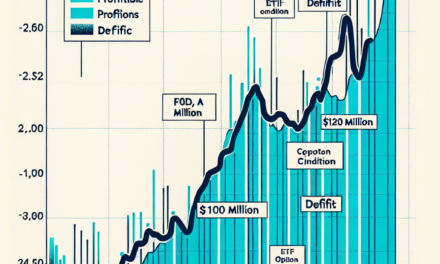“Riding the Wave: Stocks Soar as the Dollar Dominates”
Introduction
In the latest financial developments, global stock markets have experienced a notable upswing, even as the U.S. dollar reaches its highest level in a year. This unexpected rally in equities comes amid a complex economic landscape, where investors are weighing the implications of a stronger dollar on international trade and corporate earnings. The dollar’s surge, driven by robust economic data and expectations of continued monetary tightening by the Federal Reserve, has traditionally posed challenges for multinational companies by making exports more expensive and reducing the value of overseas revenues. However, the current market dynamics suggest a resilient investor sentiment, as market participants navigate through these headwinds with a focus on growth prospects and strategic positioning. This update delves into the factors driving the stock market’s ascent and the potential implications of the dollar’s strength on global financial markets.
Impact Of A Strong Dollar On Global Markets
In recent weeks, global financial markets have been closely monitoring the performance of the U.S. dollar, which has surged to a year-high, influencing various sectors and economies worldwide. This appreciation of the dollar has had a multifaceted impact on global markets, affecting everything from stock prices to commodity values. As the dollar strengthens, it exerts a significant influence on international trade, investment flows, and corporate earnings, creating a ripple effect that is felt across the globe.
One of the most immediate impacts of a strong dollar is observed in the stock markets. U.S. equities have experienced a notable climb, buoyed by the dollar’s strength. This rise can be attributed to several factors, including increased investor confidence in the U.S. economy and the relative attractiveness of dollar-denominated assets. As the dollar appreciates, foreign investors are often drawn to U.S. markets, seeking to capitalize on potential gains. This influx of capital can drive stock prices higher, as demand for equities increases. However, it is important to note that while U.S. stocks may benefit, companies with significant international exposure could face headwinds. A stronger dollar can erode the value of overseas revenues when converted back into dollars, potentially impacting corporate earnings and leading to mixed results across different sectors.
Moreover, the dollar’s ascent has significant implications for emerging markets. Many emerging economies rely heavily on dollar-denominated debt, and a stronger dollar can increase the burden of these obligations. As the cost of servicing debt rises, these countries may face financial strain, which can lead to reduced economic growth and increased volatility in their financial markets. Additionally, a robust dollar can make exports from emerging markets less competitive, as their goods become more expensive for foreign buyers. This dynamic can further exacerbate economic challenges in these regions, as trade balances are affected and growth prospects are dampened.
In the realm of commodities, the dollar’s strength has also played a pivotal role. Commodities such as oil, gold, and other raw materials are typically priced in dollars, meaning that a stronger dollar can make these goods more expensive for buyers using other currencies. Consequently, demand for commodities may decrease, leading to downward pressure on prices. This trend has been observed in recent weeks, with oil prices experiencing fluctuations as market participants weigh the impact of the dollar’s rise against other factors such as supply constraints and geopolitical tensions.
Furthermore, the dollar’s appreciation has implications for global trade dynamics. As the dollar strengthens, U.S. exports become more expensive for foreign buyers, potentially reducing demand for American goods and services. This shift can lead to a widening trade deficit, as imports become relatively cheaper and more attractive to U.S. consumers. Conversely, countries with weaker currencies may find their exports becoming more competitive, potentially boosting their trade surpluses.
In conclusion, the dollar’s surge to a year-high has had a profound impact on global markets, influencing stock prices, emerging economies, commodity values, and trade dynamics. While the U.S. stock market has benefited from increased investor interest, companies with international exposure may face challenges. Emerging markets grapple with heightened debt burdens and reduced competitiveness, while commodity prices experience downward pressure. As global markets continue to navigate these complexities, the interplay between currency strength and economic performance remains a critical area of focus for investors and policymakers alike.
Stocks Rally: Key Drivers Behind The Climb
In recent weeks, global stock markets have experienced a notable rally, driven by a confluence of factors that have bolstered investor confidence. At the forefront of this upward momentum is the robust performance of the U.S. dollar, which has surged to a year-high, influencing market dynamics in significant ways. This appreciation of the dollar, while presenting challenges for some sectors, has simultaneously provided a boost to others, creating a complex landscape for investors to navigate.
One of the primary drivers behind the stock market’s ascent is the strong economic data emerging from the United States. Recent reports have highlighted a resilient labor market, with unemployment rates remaining low and job creation exceeding expectations. This positive economic backdrop has instilled confidence among investors, who view it as a sign of sustained economic growth. Moreover, consumer spending, a critical component of the U.S. economy, has shown remarkable strength, further underpinning the optimistic sentiment in the markets.
In addition to domestic economic indicators, corporate earnings have played a pivotal role in propelling stocks higher. Many companies have reported better-than-expected quarterly results, driven by robust demand and effective cost management strategies. This earnings season has been characterized by a notable number of companies surpassing analyst expectations, which has, in turn, fueled investor enthusiasm and contributed to the upward trajectory of stock prices.
Furthermore, the Federal Reserve’s monetary policy stance has been a significant factor influencing market behavior. While the central bank has signaled its commitment to maintaining a cautious approach to interest rate hikes, it has also expressed confidence in the underlying strength of the economy. This balanced outlook has reassured investors, who are now more inclined to take on risk, buoyed by the prospect of continued economic expansion without the immediate threat of aggressive monetary tightening.
However, the dollar’s surge to a year-high has introduced a layer of complexity to the market environment. On one hand, a stronger dollar can weigh on multinational corporations by making their exports more expensive and less competitive abroad. This dynamic has been particularly challenging for sectors such as manufacturing and technology, which rely heavily on international sales. On the other hand, the dollar’s strength has attracted foreign investment into U.S. assets, as investors seek the relative safety and stability of the American economy. This influx of capital has provided additional support to the stock market, offsetting some of the negative impacts on export-driven industries.
Moreover, geopolitical developments have also played a role in shaping market sentiment. Recent diplomatic efforts to resolve trade tensions and foster international cooperation have been met with cautious optimism by investors. The prospect of reduced trade barriers and improved global economic relations has contributed to a more favorable outlook for global growth, further supporting the rally in stocks.
In conclusion, the recent climb in stock markets can be attributed to a combination of strong economic fundamentals, impressive corporate earnings, and a supportive monetary policy environment. While the dollar’s surge presents both challenges and opportunities, the overall sentiment remains positive, as investors continue to navigate the complexities of the current market landscape. As global economic conditions evolve, market participants will remain vigilant, assessing the interplay of these factors to make informed investment decisions.
Currency Fluctuations: How A Strong Dollar Affects Investments
In recent weeks, the financial markets have witnessed a notable surge in stock prices, coinciding with the U.S. dollar reaching its highest level in a year. This development has sparked considerable interest among investors and analysts, as the interplay between a strong dollar and stock market performance is a complex and multifaceted phenomenon. Understanding how currency fluctuations, particularly a robust dollar, impact investments is crucial for market participants seeking to navigate these dynamic conditions.
To begin with, a strong dollar can have both positive and negative effects on various sectors of the economy, thereby influencing stock market trends. On one hand, a stronger dollar makes U.S. exports more expensive for foreign buyers, potentially reducing the competitiveness of American goods in international markets. This can adversely affect companies with significant overseas sales, as their revenues may decline due to decreased demand. Consequently, sectors such as manufacturing and technology, which rely heavily on exports, might experience downward pressure on their stock prices.
Conversely, a strong dollar can benefit certain industries, particularly those that import raw materials or goods. For instance, companies in the retail and consumer goods sectors may find their costs reduced when purchasing foreign products, as a stronger dollar increases their purchasing power. This can lead to improved profit margins and, in turn, bolster stock prices for these companies. Additionally, a robust dollar can attract foreign investment into U.S. financial markets, as international investors seek to capitalize on favorable exchange rates, further driving up stock prices.
Moreover, the impact of a strong dollar extends beyond corporate earnings and stock prices. It also influences the broader economic landscape, including inflation and interest rates. A stronger dollar tends to exert downward pressure on inflation, as imported goods become cheaper, thereby reducing the overall cost of living. This can provide central banks with more flexibility in setting monetary policy, potentially leading to lower interest rates. Lower interest rates, in turn, can stimulate economic growth by encouraging borrowing and investment, which may further support stock market gains.
However, it is essential to consider the global context when evaluating the effects of a strong dollar on investments. In emerging markets, for example, a robust dollar can pose significant challenges. Many emerging economies rely on dollar-denominated debt, and a stronger dollar can increase the burden of repaying these obligations, potentially leading to financial instability. This can result in capital outflows from these markets, as investors seek safer havens, thereby impacting global investment portfolios.
In conclusion, the relationship between a strong dollar and stock market performance is intricate and influenced by a myriad of factors. While certain sectors may face headwinds due to reduced export competitiveness, others may benefit from lower import costs and increased foreign investment. Additionally, the broader economic implications, such as inflation and interest rates, play a crucial role in shaping market dynamics. Investors must remain vigilant and consider both domestic and international factors when assessing the impact of currency fluctuations on their portfolios. By doing so, they can better position themselves to capitalize on opportunities and mitigate risks in an ever-evolving financial landscape.
Sector Analysis: Winners And Losers In A Rising Dollar Environment
In the ever-evolving landscape of global finance, the recent surge of the U.S. dollar to a year-high has sent ripples across various sectors, creating a dynamic environment of winners and losers. As the dollar strengthens, its impact is felt unevenly across industries, influencing corporate earnings, trade balances, and investment strategies. Understanding these shifts is crucial for investors seeking to navigate the complexities of a rising dollar environment.
To begin with, the technology sector has emerged as a notable winner in this scenario. Many tech companies, particularly those based in the United States, generate a significant portion of their revenue domestically. A stronger dollar reduces the cost of imported components, thereby improving profit margins. Additionally, tech firms with substantial cash reserves in dollars benefit from increased purchasing power abroad, allowing them to invest in foreign markets or acquire international companies at a more favorable exchange rate. Consequently, the technology sector has seen a boost in investor confidence, reflected in rising stock prices.
Conversely, the manufacturing sector faces challenges as the dollar appreciates. U.S. manufacturers that rely heavily on exports find their products becoming more expensive for foreign buyers, potentially leading to a decline in international sales. This situation is exacerbated for companies with significant operations in emerging markets, where local currencies have depreciated against the dollar. As a result, these firms may experience reduced competitiveness and pressure on profit margins, prompting some to reconsider their global supply chain strategies.
In the realm of commodities, the impact of a stronger dollar is multifaceted. Commodities such as oil, gold, and agricultural products are typically priced in dollars, meaning that as the dollar strengthens, these goods become more expensive for buyers using other currencies. This can lead to decreased demand and downward pressure on prices. However, for U.S.-based producers, the situation can be advantageous as their costs remain stable while revenues from exports increase in value when converted back to dollars. Thus, the commodities sector presents a mixed picture, with outcomes varying based on geographic location and market positioning.
The financial sector also experiences distinct effects from a rising dollar. Banks and financial institutions with significant international exposure may face headwinds as foreign earnings translate into fewer dollars. However, those with a domestic focus or substantial dollar-denominated assets stand to gain. Moreover, a strong dollar often coincides with expectations of higher interest rates, which can enhance net interest margins for banks, further boosting their profitability. Consequently, the financial sector’s performance is closely tied to the interplay between currency movements and monetary policy expectations.
In conclusion, the ascent of the U.S. dollar to a year-high has created a complex tapestry of opportunities and challenges across various sectors. While technology companies and certain commodity producers may find themselves in advantageous positions, manufacturers and firms with significant foreign exposure must navigate a more difficult landscape. Investors, therefore, need to adopt a nuanced approach, considering both the direct and indirect effects of currency fluctuations on their portfolios. By staying informed and agile, they can better position themselves to capitalize on the shifting dynamics of a rising dollar environment.
Investor Sentiment: Navigating Market Volatility
Investor sentiment has been a focal point in recent weeks as global markets experience a notable uptick in volatility. This volatility, while unsettling for some, has presented opportunities for others, particularly as stocks have shown resilience by climbing amid the dollar’s surge to a year-high. The interplay between these market dynamics underscores the complexity of navigating the current financial landscape.
To begin with, the recent ascent of the U.S. dollar has been a significant factor influencing investor behavior. The dollar’s strength, reaching levels not seen in over a year, can be attributed to a confluence of factors, including robust economic data and expectations of continued monetary tightening by the Federal Reserve. As the dollar appreciates, it exerts pressure on multinational corporations by making their goods more expensive abroad, potentially impacting earnings. However, this currency strength also reflects confidence in the U.S. economy, which can bolster investor sentiment domestically.
In parallel, stock markets have demonstrated a surprising degree of resilience. Despite the headwinds posed by a strong dollar, equities have managed to climb, suggesting that investors are focusing on underlying economic fundamentals and corporate earnings potential. This optimism is further fueled by sectors that are less sensitive to currency fluctuations, such as technology and healthcare, which continue to show robust growth prospects. Moreover, the recent earnings season has provided a mixed but generally positive picture, with many companies surpassing expectations, thereby reinforcing confidence in the market’s upward trajectory.
Transitioning to the broader economic context, it is essential to consider the role of central banks in shaping market sentiment. The Federal Reserve’s stance on interest rates remains a pivotal factor, as investors closely monitor any signals regarding future policy adjustments. The anticipation of rate hikes has been a double-edged sword; while it supports the dollar’s strength, it also raises concerns about borrowing costs and their potential impact on economic growth. Nevertheless, the Fed’s commitment to managing inflation while supporting economic recovery provides a degree of reassurance to market participants.
Furthermore, geopolitical developments continue to add layers of complexity to the investment landscape. Trade tensions, political uncertainties, and global supply chain disruptions are among the myriad factors that investors must weigh when making decisions. These elements contribute to the prevailing market volatility, prompting a more cautious approach among some investors. However, for those with a long-term perspective, such volatility can present opportunities to acquire quality assets at more attractive valuations.
In conclusion, navigating market volatility requires a nuanced understanding of the various forces at play. The recent climb in stocks amid the dollar’s surge highlights the importance of considering both macroeconomic indicators and sector-specific dynamics. While challenges remain, particularly with regard to currency fluctuations and geopolitical uncertainties, the resilience of equities suggests that investors are finding ways to adapt to the evolving landscape. As always, maintaining a diversified portfolio and staying informed about market developments are crucial strategies for managing risk and capitalizing on opportunities in these uncertain times.
Economic Indicators: What A Strong Dollar Means For The Economy
In recent weeks, the financial markets have witnessed a notable surge in stock prices, coinciding with the U.S. dollar reaching its highest level in a year. This development has sparked discussions among economists and investors about the implications of a strong dollar on the broader economy. Understanding the dynamics of a robust dollar is crucial, as it influences various economic indicators and sectors, shaping the financial landscape in significant ways.
A strong dollar typically reflects confidence in the U.S. economy, often driven by factors such as higher interest rates, robust economic growth, or geopolitical stability. As the dollar appreciates, it enhances the purchasing power of American consumers and businesses, making imported goods and services more affordable. This can lead to increased consumer spending, a critical component of economic growth. Moreover, a strong dollar can help curb inflationary pressures by reducing the cost of imports, thereby contributing to price stability.
However, the benefits of a strong dollar are not uniformly distributed across the economy. While consumers may enjoy lower prices on imported goods, U.S. exporters face challenges as their products become more expensive for foreign buyers. This can lead to a decline in export competitiveness, potentially impacting industries reliant on international markets. Consequently, companies with significant overseas operations may experience reduced revenues, affecting their stock performance and, by extension, the broader stock market.
In addition to affecting trade balances, a strong dollar can influence capital flows. Investors often seek higher returns, and a strong dollar can attract foreign capital into U.S. financial markets. This influx of capital can drive up stock prices, as seen in the recent market rally. However, it can also lead to volatility, as shifts in currency values can prompt rapid changes in investment strategies. Furthermore, emerging markets may face challenges as a strong dollar increases the burden of dollar-denominated debt, potentially leading to financial instability in those regions.
The interplay between a strong dollar and monetary policy is another critical consideration. The Federal Reserve closely monitors currency fluctuations as part of its mandate to ensure economic stability. A strong dollar can influence the Fed’s decisions on interest rates, as it may reduce the need for aggressive rate hikes to combat inflation. However, the central bank must balance these considerations with the potential impact on domestic growth and employment.
In the context of global trade, a strong dollar can also affect the balance of power among major economies. Countries with weaker currencies may find it challenging to compete with U.S. goods and services, potentially leading to trade imbalances and tensions. This dynamic underscores the importance of international cooperation and dialogue to address currency-related issues and maintain a stable global economic environment.
In conclusion, the recent surge in stock prices amid the dollar’s year-high strength highlights the complex interplay between currency values and economic indicators. While a strong dollar can bolster consumer purchasing power and attract foreign investment, it also poses challenges for exporters and emerging markets. As policymakers and investors navigate this landscape, understanding the multifaceted effects of a strong dollar is essential for making informed decisions that promote sustainable economic growth. By considering these factors, stakeholders can better anticipate the potential impacts on various sectors and adjust their strategies accordingly, ensuring resilience in an ever-evolving global economy.
Strategies For Investors: Capitalizing On Market Trends
In the ever-evolving landscape of global finance, investors are constantly seeking strategies to capitalize on market trends. Recently, the stock market has experienced a notable climb, coinciding with the U.S. dollar reaching a year-high surge. This dual development presents both opportunities and challenges for investors aiming to optimize their portfolios. Understanding the interplay between these two market forces is crucial for devising effective investment strategies.
To begin with, the rise in stock prices can be attributed to several factors, including robust corporate earnings, positive economic indicators, and investor optimism. Companies across various sectors have reported better-than-expected earnings, which has bolstered investor confidence and driven stock prices upward. Additionally, economic indicators such as employment rates and consumer spending have shown resilience, further supporting the bullish sentiment in the stock market. As a result, investors are increasingly inclined to allocate more capital to equities, seeking to benefit from the upward momentum.
However, the concurrent surge in the U.S. dollar adds a layer of complexity to investment strategies. A stronger dollar can have mixed implications for different sectors and asset classes. On one hand, it can benefit domestic companies that rely on imported goods and services, as their purchasing power increases. On the other hand, it poses challenges for multinational corporations with significant overseas revenue, as their earnings may be negatively impacted when converted back to dollars. Consequently, investors must carefully assess the currency exposure of their portfolios and consider potential hedging strategies to mitigate risks associated with currency fluctuations.
Moreover, the dollar’s strength can influence commodity prices, as many are priced in U.S. dollars. A stronger dollar often leads to lower commodity prices, which can affect sectors such as energy and materials. Investors with exposure to these sectors should closely monitor commodity trends and consider diversifying their holdings to reduce potential volatility. Additionally, the impact of a strong dollar on emerging markets cannot be overlooked. Emerging market economies with significant dollar-denominated debt may face increased repayment burdens, potentially leading to financial instability. Investors should remain vigilant and evaluate the credit risk associated with their emerging market investments.
In light of these dynamics, diversification remains a key strategy for investors seeking to capitalize on current market trends. By spreading investments across various asset classes, sectors, and geographic regions, investors can reduce risk and enhance potential returns. Furthermore, incorporating alternative investments such as real estate, commodities, or hedge funds can provide additional diversification benefits and serve as a hedge against market volatility.
Another strategy to consider is adopting a long-term investment perspective. While short-term market fluctuations can be unsettling, maintaining a focus on long-term goals can help investors navigate periods of uncertainty. By staying committed to a well-defined investment plan and avoiding impulsive decisions based on short-term market movements, investors can better position themselves to achieve their financial objectives.
In conclusion, the recent climb in stock prices amid the dollar’s year-high surge presents a complex yet promising landscape for investors. By understanding the interplay between these market forces and employing strategies such as diversification and a long-term perspective, investors can effectively capitalize on current trends while managing associated risks. As always, staying informed and adaptable in response to evolving market conditions will be essential for achieving investment success.
Q&A
1. **Question:** What recent trend has been observed in the stock markets?
– **Answer:** Stocks have been climbing.
2. **Question:** What is happening with the U.S. dollar in the current market update?
– **Answer:** The U.S. dollar has surged to a year-high.
3. **Question:** How are investors reacting to the dollar’s surge in relation to stocks?
– **Answer:** Investors are showing optimism, leading to a rise in stock prices despite the dollar’s strength.
4. **Question:** What sectors are contributing to the stock market’s climb?
– **Answer:** Technology and financial sectors are among those contributing to the stock market’s climb.
5. **Question:** How does a strong dollar typically affect multinational companies?
– **Answer:** A strong dollar can negatively impact multinational companies by making their exports more expensive and reducing overseas revenue when converted back to dollars.
6. **Question:** What external factors are influencing the current market conditions?
– **Answer:** Factors such as economic data releases, central bank policies, and geopolitical developments are influencing market conditions.
7. **Question:** What is the general sentiment among market analysts regarding the future of stocks amid the dollar’s rise?
– **Answer:** Market analysts are cautiously optimistic, noting that while a strong dollar poses challenges, underlying economic fundamentals remain supportive of stock growth.
Conclusion
The recent market update indicates a positive trend in stock performance despite the U.S. dollar reaching a year-high surge. This suggests that investor confidence remains strong, potentially driven by robust corporate earnings, favorable economic data, or other market dynamics that outweigh the potential negative impact of a stronger dollar. The resilience of stocks in the face of a rising dollar highlights the complexity of market forces and the ability of equities to perform well even when currency fluctuations present challenges. Overall, the current market environment reflects a balance between currency strength and stock market optimism.





